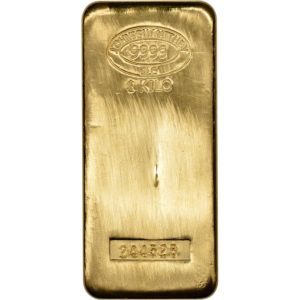Here’s everything you need to know about what type of gold bar to buy in 2025. You’ll learn when to choose gold bars over gold coins, what size gold bar to buy and a whole lot more…
Table of Contents
Estimated reading time: 9 minutes
Here’s How to Choose What Type of Gold Bar to Buy
So you’ve considered the many reasons why you should buy gold and have made a decision to buy. You’ve also determined what percentage of precious metals you should own.
Now the question is what type of gold to buy? First up, you’ll most likely want to consider whether to buy gold bars or buy gold coins.
Why Buy Gold Bars?

The main reason to buy gold bars is because they are cheaper than gold coins. Gold coins require more “work” to produce them. They have the added work of designing both a front and back (or obverse and reverse) of the coin. But also the minting and machining process for a coin is far more involved than for a bar.
For more detail on the coins vs bars debate see: NZ Gold Coins or NZ Gold Bars: Which Should I Buy?
Therefore if your primary concern is simply to get the most gold for your money, then gold bars are probably the way to go.
What Size Gold Bar Should I Buy?
The next question to answer is what size gold bar to buy? Gold bars come in a plethora of sizes, from 1 gram to 400 ounces.
The general rule of thumb is, the bigger the bar the lower the premium over spot price per ounce. i.e. a bigger bar is a cheaper bar.
Why is that?

Well, it’s comparable to how a coin requires more “work” to produce than a bar. In much the same way, a larger bar requires about the same amount of work to pour or cast as a smaller bar.
So the net cost of fabricating the bars is quite similar. But a larger bar obviously has much more gold in it.
Therefore the overall cost per ounce of a much larger bar (such as a 1 kilogram bar) is lower than say a 1 ounce gold bar.
However like many things in life cheaper is not always the best option. More on that below…
Pros and Cons of Different Bar Sizes
400 ounce gold bars and 1kg gold bars offer the best value. That is you’ll get more ounces of gold for the same amount of money. That is why the likes of large institutional investors, central banks and exchange traded funds deal in 400 ounce bars. Exchanges in China more commonly deal in the kilo bar.
But there are disadvantages to buying larger bars. These include:
- Divisibility – a 1 kilogram gold bar cannot be sliced up into smaller parcels and sold when the need arises.
- Counterfeiting – Although counterfeiting of gold is not common, larger bars are a more likely target for counterfeiters. Why? Because there is a less chance of counterfeiting occurring in smaller 1 ounce bars, as it is not worth the time and effort. (The other main way to avoid counterfeits is to deal with a long standing gold dealer who sources direct from precious metals refiners and mints).
- Ease of resale – There are more potential buyers of smaller bars. Not many people can afford a 400oz gold bar, so when the time comes to sell you will have a smaller pool of interested buyers.
1kg Gold Bar Advantage: 1kg Bars Can be Borrowed Against
While we view gold as financial insurance with no counter-party risk, there are times when some people would like to be able to borrow against their gold.
Say you wanted to purchase a property, but didn’t want to sell the gold you had in order to do this. You may therefore choose to borrow against your gold.
As the only New Zealand brokers for the Singapore Precious Metals Exchange (SGPMX), we have an option available to borrow against gold stored in Singapore.
This borrowing is only available against 1kg gold bars. The minimum is 3 kilos of gold. Go here for more information about storage at SGPMX and to request more information about borrowing against gold.
What is the Most Common Gold Bar Size That is Bought?
By far the most common size gold bar we sell is the 1 oz gold bar. Why?
Most likely because the 1 ounce gold bar is the best combination of lower premium above spot price, and resale-ability. A 1oz bar is not too high a value. So if buying a number of ounces of gold you can sell them later in tranches.
(Tip: If you want even greater divisibility then consider buying silver coins.)
Other Factors to Consider When Buying Gold Ingots and Bars
Different Brands of Gold Bars
There is a vast range of brands available when buying different types of gold bars. These include local New Zealand refined gold brands and overseas brands.

Overseas refiners include:
- PAMP
- Argor-Heraeus
- Johnson Matthey
- Metalor
Overseas options also include sovereign mints such as:
- Perth Mint
- Royal Canadian Mint
- US Mint
Again there are pros and cons to buying locally refined New Zealand made gold bars and imported/overseas made gold bars. This article covers these advantages and disadvantages in detail: PAMP Suisse Gold / Silver vs Local NZ Gold / Silver: Which should I buy?
Regardless of what gold bar you buy, there are a few things you should expect to see on it.
The refiners hallmark should be cast or stamped into the gold bar. Also clearly visible should be the purity of the bar. Generally this will be 9999 purity or 99.99% pure. Some larger bars (1 kilogram and 400 ounce) may only be 999 pure. Finally the weight in either grams, ounces, or kilograms.
Some brands and sizes may also be cast or minted with a unique serial number. Some may also ship with certification. Generally you will also pay more for these types of bars.
No GST on Gold Over 99.5% Pure
This point is generally not of concern when buying different types of gold bars as almost all are 999 or 9999 pure. However some coins such as the South African Krugerrand and American Eagle 1oz gold coins are only 22 carat or 91.67 pure. These 22 carat gold coins therefore attract GST in New Zealand and so are not a great buy here.
Cast Bars vs Minted Bars
What is a Gold Cast Bar?
A cast bar simply means the gold has been melted and then poured into a cast or mould. This cast will have the refiners hallmark stamped into it along with the weight and purity.
A cast bar may also be referred to as a moulded bar, poured bar or a gold ingot. The word ingot and bar are often used interchangeably. See: 1oz Gold Cast Bar
What is a Gold Minted Bar?

Whereas a minted bar is produced in a similar way to a coin. There are multiple steps involved. There is still a casting process to produce a bar of a certain size. But then the bar is fabricated via a striking process. A machine strikes the bar – effectively stamping it with a design much like a coin is. See: 1oz Gold Minted Bar
Pros and Cons of Cast and Minted Bars
Cast bars are cheaper to produce, therefore are cheaper to buy. They can also have some variation between bars due to the casting process. However this comes down to personal preference. Some people prefer the individuality of a cast bar, while others prefer the exactness of a minted bar.
Minted bars have more detail in their design. The minting process is of course what gives the minted bar a higher price compared to a cast bar. While you may pay more for a minted bar there is also no guarantee you will get more for it when you sell it, compared to a cast bar. Minted bars usually come in packaging, so if you’d like to handle your gold bar, a cast bar may be a better option.
For more on minted bars and gold coins see: Why is a 1oz PAMP Gold Lady Fortuna Minted Bar Worth Less Than a Canadian Gold Maple Coin?
How Have Gold Bar Prices Changed Since April 2022?
This article was previously updated in April 2022 and February 2024. So we thought it would be interesting to look back and compare how the price for a couple of different gold bars have changed since then.
On 27 April 2022 a 1 oz Local NZ refined Gold bar sold for $3,004.00. While in February 2024 it was $3,390.10. Today that same bar retails for $5,830.50.
While a 1kg Scottsdale Mint Gold bar was $95,867.09 in 2022. Just under 2 years later the same bar sold for $108,853.56. Now in 2025 it is $187,792.33!
So gold bars are around 95% more expensive today in 2025 than they were in 2022.
Gold Bars Stand the Test of Time
Gold bars are a popular way to protect purchasing power and guard against financial crises. They are an asset that has stood the test of time for millennia. The prices above show that gold bars have given protection against the high inflation of the past couple of years.
Check out the different types of gold bars to buy. Or let us know if you’d like something not listed there. You can also use the live chat feature to get the most up to date pricing – see the button at the bottom right of your screen.
Related: What is the Best Type of Gold to Buy For Trading in a Currency Collapse?
Editors Note: Originally posted 24 April 2018. Last updated 5 August 2025.


Pingback: NZ Gold Coins (and Silver Coins) or NZ Gold Bars (and Silver Bars): Which Should I Buy?
Pingback: What Good is a Bar of Gold When the Shelves are Empty?
Pingback: Choosing Between PAMP Suisse Gold & Silver vs Local NZ Gold & Silver Bars: Video
Pingback: Why is a 1oz PAMP Gold Lady Fortuna Minted Bar Worth Less Than a Canadian Gold Maple Coin? - Gold Survival Guide
Pingback: Paper Gold vs Physical Gold - What Should You Buy? - Gold Survival Guide
Pingback: Is There a Kiwisaver Gold Fund or Gold Investment Option? - Gold Survival Guide
Pingback: Why Buy Silver? Here's 21 Reasons to Buy Silver Now
Pingback: Better to Buy Gold by the Ounce or the Gram? - Gold Survival Guide
Pingback: Silver Close to a Bounce Back? - Gold Survival Guide
Pingback: What Are The Different Types of Gold Bars? - Gold Survival Guide
Pingback: Gold Open Interest Lowest in 5 Years - So What? - Gold Survival Guide